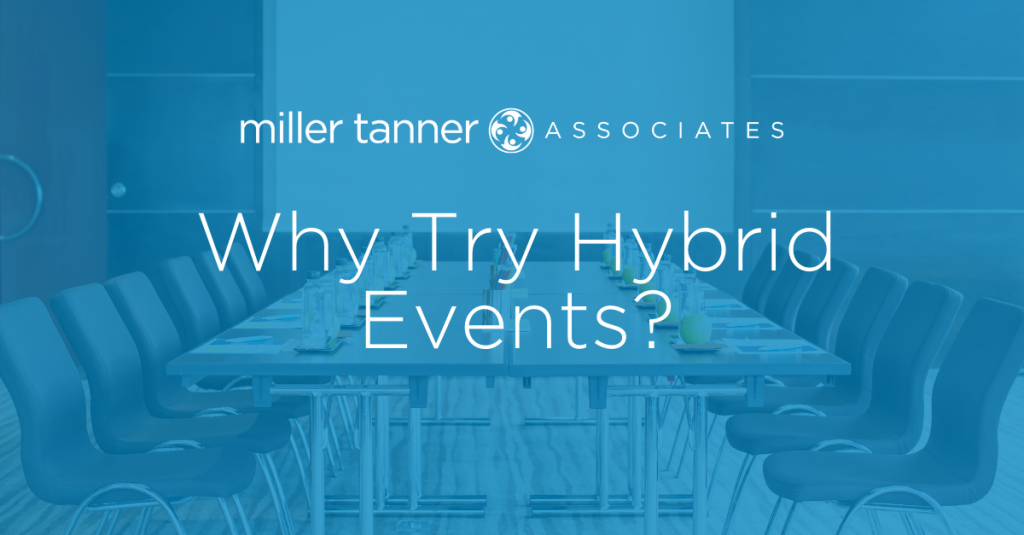
What is a Hybrid Event?
Essentially, a hybrid event is any combination of a face-to-face and virtual or digital experience.
You might have a 5,000-person virtual event with 20 people joining in person in one location. Or you might have 100 people face-to-face in meeting rooms and 100 people attending virtually online. Or you could have 5000 attendees with a live speaker being recorded and filmed at a remote location. These are just a few examples of the countless options that hybrid events can offer. Bottom line: With hybrid meetings, the event possibilities are endless.
Why Hybrid Events Are a Good Solution Especially Now
Hybrid events have always been a great solution. For years at MTA, we’ve been using a combination of face-to-face, virtual, and hybrid events to enhance learning, strengthen the conversation before or after an event, boost return on investment and improve audience connection.
Now that companies are forced to go virtual due to the current pandemic, organizations have lost their “fear factor”, have stepped outside their comfort zone, and have started to think outside the box; now there’s curiosity around what it looks like to extend and further engage their audience in the future.
Easily Pivot Your Meeting During an Unpredictable Time with Hybrid Events
As many companies have pivoted their face-to-face events to virtual as a result of the pandemic, this trend will continue in 2021 with a hybrid model. Hybrid events will be necessary to allow all attendees to participate at their comfort level. For those individuals where it’s safe to return to in-person events, they can participate face-to-face; and for those who have reasons why they can’t attend face-to-face, hybrid enables them the opportunity to attend the events without being in person.
Advantages of Hybrid Events
Expand Your Audience
One important advantage of hybrid events is the ability to expand your audience to include those who cannot travel to the event but can still attend the event virtually. The idea of attrition begins to shift – It’s not a traditional attrition model anymore of who can’t attend the event, but rather those who can’t attend in-person now have a second opportunity to say yes to your event.
Additionally, audiences are hungry for great content and for exceptional virtual experiences. They want to learn more, attend more, and experience more. This particular time period in our history allows so many people to expand their horizons and their knowledge base.
As a result, we’re not seeing a decline in hybrid or virtual audiences; we’re seeing increases in expansions of audiences allowing for reach that didn’t exist before.
It’s an opportunity to embrace and recognize that there is an audience, that they want to be engaged, and that if we provide great content, and engaging experiences, then they’ll continue to come and, and feast off of what we’re sharing.
Ensure Safety during Uncertainty
Safety certainly is a very important issue. There will be COVID-related restrictions for all face-to-face events moving forward, but some of those restrictions, guidelines and safety measures aren’t enough for certain portions of your audience who may be impacted for a variety of other reasons such as health risk factors for themselves or someone with whom they live or childcare limitations.
The hybrid event then enables you to customize your event, to ensure everyone feels comfortable at the level at which they’re able to engage. And for some people that will be virtual and for some people that will be face-to-face.
Flexible, Built-In Contingency Planning
The great advantage of a hybrid model is that it offers a built-in contingency plan should situations change.
For example, 12 weeks from now, the country or the region in which you are conducting your event, or from where your audience is traveling, needs to move fully virtual due to imposed travel restrictions. By planning a hybrid event to be fully executed alongside your primary face-to-face event, you can quickly convert your entire conference into a full virtual experience.
Why MTA is the Right Partner for your Hybrid Event
Experience and Expertise
One of the benefits of working with Miller Tanner Associate is that we have been planning virtual events for the past 10 years for our clients. Our company, itself has been a virtual company for 23 years.
Over the past five years, a high percentage of our in-person events have been converting to virtual. There’s always been a virtual component to our face-to-face events, whether it’s a small virtual audience or a small group of virtual speakers. As a result, we have a high level of experience helping our clients determine how to engage people virtually.
Return on Your Investment
Helping clients create a return on investment is another benefit of working with an event planner like Miller Tanner Associates. Working with our team shows you how to create this ROI, as it doesn’t necessarily happen naturally in a virtual or a hybrid scenario. It requires core planning, structuring your agenda to maximize your content delivery, and employing technologies to ensure engagement.
We’ve done the testing within our own team, and with years of experience in using the virtual model, we take that trial and error out of the way for you.
Beyond Plan B
We want our partners to have peace of mind with every corporate event planning. Moving forward in 2021, every face-to-face event will have a shadow hybrid event plan integrated meaning a virtual event is being planned alongside the in-person event in case the event requires a sudden pivot to virtual or hybrid.
Hybrid events are truly the best of both worlds. The hybrid model offers an effective way to maximize and personalize an event experience that can accommodate any audience both in-person or remote. To learn more about hybrid events, contact our Global Experiences Team.


